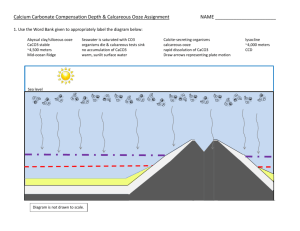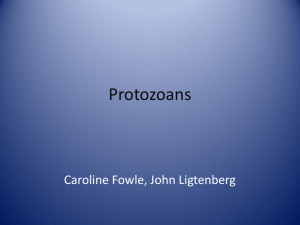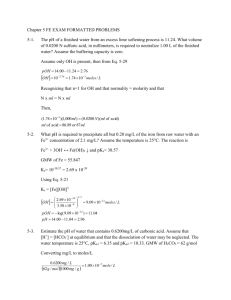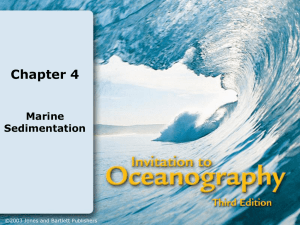Calcium Carbonate Compensation Depth
advertisement
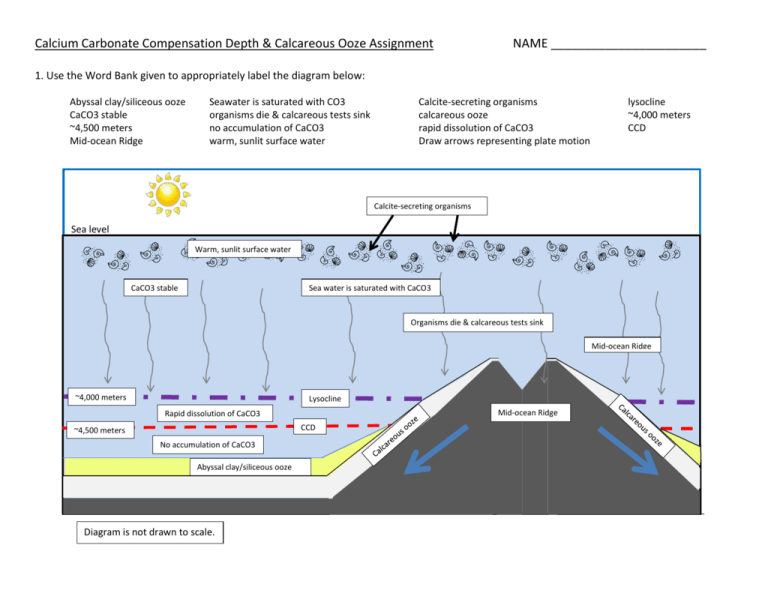
Calcium Carbonate Compensation Depth & Calcareous Ooze Assignment NAME _______________________ 1. Use the Word Bank given to appropriately label the diagram below: Abyssal clay/siliceous ooze CaCO3 stable ~4,500 meters Mid-ocean Ridge Seawater is saturated with CO3 organisms die & calcareous tests sink no accumulation of CaCO3 warm, sunlit surface water Calcite-secreting organisms calcareous ooze rapid dissolution of CaCO3 Draw arrows representing plate motion lysocline ~4,000 meters CCD Calcite-secreting organisms Sea level Warm, sunlit surface water CaCO3 stable Sea water is saturated with CaCO3 Organisms die & calcareous tests sink Mid-ocean Ridge ~4,000 meters stable Lysocline CCD ~4,500 meters stable Mid-ocean Ridge Rapid dissolution of CaCO3 No accumulation of CaCO3 dissolves Abyssal clay/siliceous ooze stable Diagram is not drawn to scale. 2. Define the term ‘calcium carbonate compensation depth’. What is the average depth of the CCD, in meters & in feet? The calcium carbonate compensation depth (CCD) is the depth at which the rate of accumulation of calcium carbonate is equal to the dissolution of calcium carbonate. The average depth is 4,500 meters (15,000 feet). 3. Describe the different conditions that cause CaCO3 to dissolve. Include the chemical reaction for the dissolution of calcium carbonate. CaCO3 dissolves in sea water due to colder temperatures, higher pressures, and a high CO2 content which results in a lower pH. The chemical reaction for dissolution is: CaCO3 + H2O + CO2 Ca++ + 2HCO3- 4. As the calcareous tests sink, does the dissolution occur gradually with depth or suddenly once the CCD is reached? Explain. The dissolution of calcium carbonate tests occurs gradually once the organisms die and sink below the calcite saturation horizon. With continued sinking, at approximately 4,000 meters, the lysocline is reached, which marks the level of rapid, increasing dissolution with increasing depth. The lysocline marks the boundary between well preserved and poorly preserved foraminifers. Once the CCD is reached, at approximately 4,500 meters, no calcium carbonate accumulates. 5. Define ‘calcareous ooze’. List the two main types of organisms that contribute to this biogenous sediment. Calcareous ooze contains up to 30% of the hard remains of organisms that have CaCO3 tests mixed with ~70% of lithogenous clay. Foraminifers are single-celled protozoans with a hard calcium carbonate test and Coccolithophores are microscopic algae that consist of calcium carbonate plates. 6. Calcareous oozes can be found in sediment cores drilled from locations in waters deeper than the CCD. Explain how this occurs with regards to plate tectonics and deposition of sediment. Mid-ocean ridges are commonly at an elevation above the CCD therefore calcareous ooze can accumulate on top. As sea-floor spreading occurs and the plates move away in opposite directions, abyssal clays or siliceous oozes are deposited on top of the calcareous ooze and the plates eventually subside below the CCD. The abyssal clay/siliceous ooze layer thus protects the calcareous ooze from being exposed to the cold, acidic sea water and dissolved. 7. Where can a high percentage of calcareous ooze be found in modern ocean sediments around the globe? Explain why this occurs. The distribution of modern calcareous ooze is generally found along mid-ocean ridges and in low-latitude ocean basins. The reason for this occurrence is that most mid-ocean ridges are at a level higher than the CCD and that low-latitude ocean basins are typically warm and often not as deep as the CCD. 8. If you were vacationing on a cruise ship and the captain informed you that your current position was over the Juan de Fuca Ridge at 46o N latitude, would you expect calcareous ooze to be accumulating? Why or why not? No, calcareous ooze would not accumulate. Even though the Juan de Fuca mid-ocean ridge is topographically higher than the CCD, it is located at high latitudes where cold ocean currents are originating from Alaska. Therefore, the water temperature is too cold for abundant CaCO3 secreting organisms to proliferate and calcareous ooze to form.
